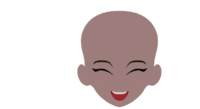I have only tried the original Star, and had some fun with her unusual proportions, and even created a full body morph to provide a whole new shape for her. However, I wasn't thrilled by the way her "hollow" eyes were built. They force us to rely on shaders to be able to make them work in different rendering engines, or else the hollow parts will show. Not ideal for the kinds of toon renders I like to do.
But what I want to emphasize here is the extra level of versatility we get from universal heads. If you choose Star or Nana, you are tied up to their specific wardrobe and platform. With a universal head, you can choose any figure and platform, so your characters will always have the right body and wardrobe you need for your renders. For example, Star 2 doesn't work in Poser, and I don't use G3F. Cookie is a very cute "chibi-like" figure, but here again, her facial expressions are terribly limited. And what if the outfit you want for the character only exists for a specific figure? No problem - bring the universal head there.
This is why the universal heads am I making have very specific styles that are not available with existing figures. What about AnimeDoll? She has a great Anime look, but she has no body morph, her rigging is not stellar, her wardrobe is very limited, and she has very little expression dials. So even if I replace a modern figure's head with her's (there is one for Genesis), her facial expressions are still very limited. Those are some of the key factors that led me to create universal heads in specific styles (Anime and Chibi). This can also breath new life into your older contents, by giving them a whole new look they could never have before.
But what I want to emphasize here is the extra level of versatility we get from universal heads. If you choose Star or Nana, you are tied up to their specific wardrobe and platform. With a universal head, you can choose any figure and platform, so your characters will always have the right body and wardrobe you need for your renders. For example, Star 2 doesn't work in Poser, and I don't use G3F. Cookie is a very cute "chibi-like" figure, but here again, her facial expressions are terribly limited. And what if the outfit you want for the character only exists for a specific figure? No problem - bring the universal head there.
This is why the universal heads am I making have very specific styles that are not available with existing figures. What about AnimeDoll? She has a great Anime look, but she has no body morph, her rigging is not stellar, her wardrobe is very limited, and she has very little expression dials. So even if I replace a modern figure's head with her's (there is one for Genesis), her facial expressions are still very limited. Those are some of the key factors that led me to create universal heads in specific styles (Anime and Chibi). This can also breath new life into your older contents, by giving them a whole new look they could never have before.

